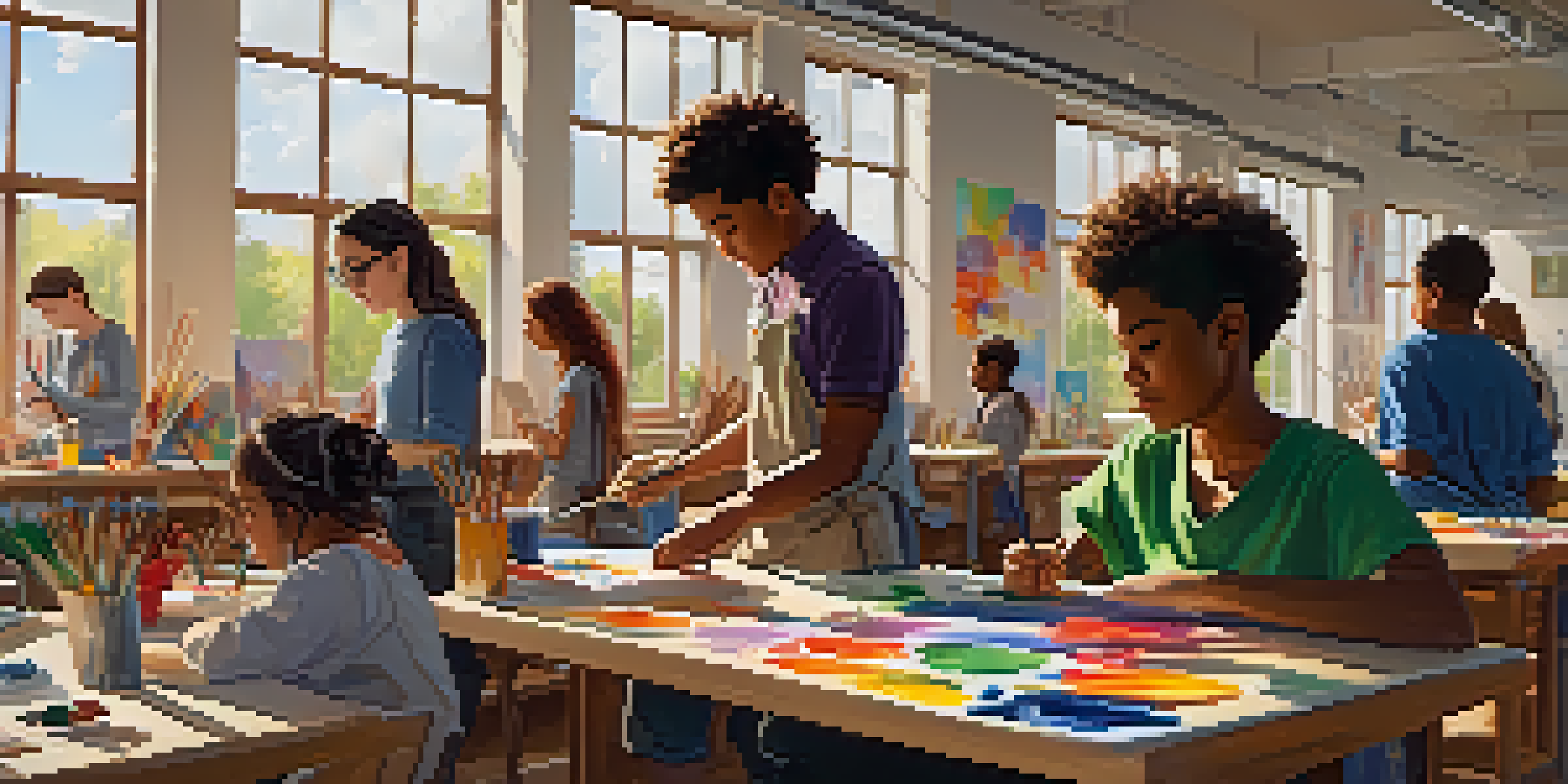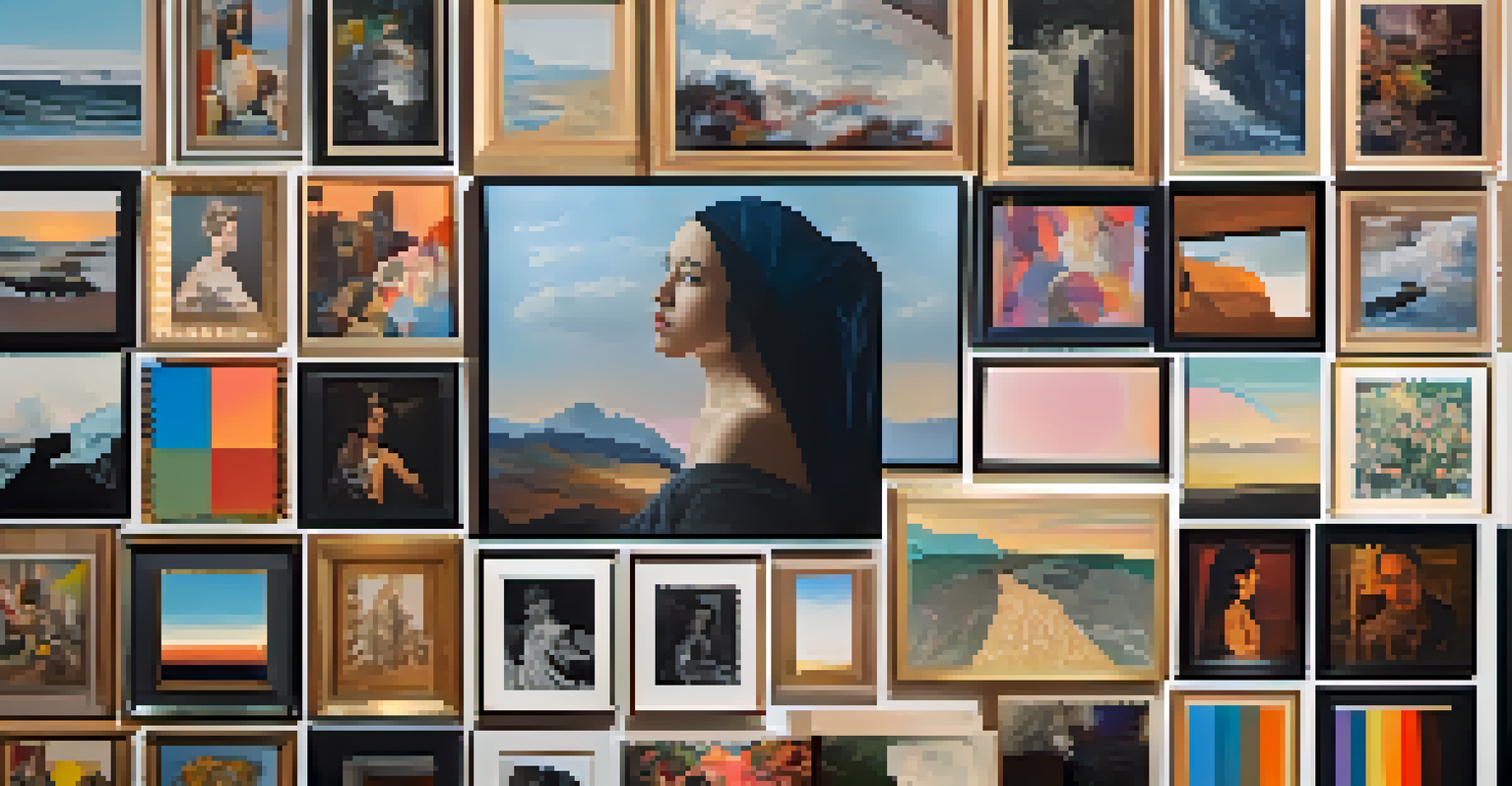The Role of Gender in Art Education: A Comparative Study

Understanding Gender Roles in Art Education
Gender roles have long shaped educational environments, including art education. Traditionally, certain artistic practices have been associated with masculinity or femininity, influencing how students engage with art. For instance, boys might be encouraged to pursue more technical forms of art, while girls may be steered towards more expressive or decorative styles. This historical context sets the stage for examining current practices and attitudes in art education.
Art is a way of expressing our identity, and it should be inclusive of all voices, regardless of gender.
The way educators perceive and interact with students can also reflect these gender biases. Teachers may unknowingly favor certain styles or mediums based on a student's gender, which can impact their confidence and creative expression. Understanding these dynamics is crucial for fostering an inclusive environment where all students feel empowered to explore their artistic potential. By acknowledging these roles, we can begin to address disparities and create a more equitable art education landscape.
Ultimately, recognizing and challenging traditional gender roles in art education can lead to more diverse and rich artistic expressions. As educators, it’s important to cultivate an environment that encourages exploration beyond gender norms. This not only enhances creativity but also prepares students to appreciate a wide range of artistic contributions, regardless of the artist's gender.
Historical Perspectives on Gender in Art Education
To understand the current state of gender in art education, we must first look back at its history. Art education has often mirrored societal values, with gendered expectations influencing curriculum design and teaching methods. Historically, women faced significant barriers to formal art training and recognition, which has had lasting effects on their representation in the art world. These historical trends help explain why gender disparities persist in contemporary art education.

Moreover, the art movements of the past have often celebrated male artists, overshadowing the contributions of women and non-binary individuals. This historical bias can create a ripple effect in education, as students may internalize the notion that only certain genders are capable of producing 'great' art. By critically examining these historical narratives, educators can work to dismantle the biases that continue to affect students today.
Gender Roles Shape Art Education
Traditional gender roles influence how students engage with art, often steering boys and girls toward different artistic practices.
Recognizing the historical context allows educators to reframe their approach to teaching art. By including diverse perspectives and highlighting the achievements of artists across the gender spectrum, educators can inspire a new generation of artists who are aware of, and actively challenge, these historical inequities.
Gender Representation in Art Curriculum
The art curriculum plays a pivotal role in shaping students' understanding of gender and creativity. A curriculum that predominantly features male artists may inadvertently send the message that male artists are more important or relevant. Conversely, a balanced curriculum that includes a variety of artists from different genders and backgrounds can foster a richer appreciation for diverse artistic expressions. This inclusivity not only enhances the learning experience but also validates the experiences of all students.
To create art is to be part of a dialogue that transcends gender, touching the essence of what it means to be human.
Additionally, incorporating lessons on gender representation in art can spark important discussions among students. These conversations encourage critical thinking and allow students to explore how gender influences both the creation and interpretation of art. For instance, examining works by female artists can challenge stereotypes and broaden students' perspectives on what constitutes 'great' art.
Ultimately, a thoughtfully designed curriculum can empower students to embrace their unique voices and artistic identities. By diversifying the curriculum, educators can nurture a supportive environment where students feel represented and inspired to express themselves without the constraints of traditional gender norms.
Impact of Gender on Student Engagement in Art
Gender can significantly influence how students engage with art education. Research has shown that boys and girls often approach art-making differently, with boys typically favoring competitive and technical aspects, while girls may lean towards collaborative and expressive activities. This difference in engagement styles can shape students' overall experiences in the art classroom. Understanding these tendencies can help educators tailor their teaching methods to better meet the needs of all students.
Moreover, the social dynamics among students can also be influenced by gender. For example, boys may feel pressured to assert their artistic abilities in more visible ways, while girls might be more inclined to seek validation through peer collaboration. These patterns can affect participation levels and the overall classroom atmosphere. By fostering an inclusive and supportive environment, educators can help all students feel comfortable expressing their creativity.
History Affects Current Dynamics
The historical lack of recognition for female and non-binary artists continues to impact gender representation in contemporary art education.
Encouraging diverse engagement strategies can lead to a more equitable art education experience. By recognizing and valuing different approaches to art-making, educators can help students develop their unique artistic voices, irrespective of gender. This not only enhances individual creativity but also promotes a sense of community and collaboration in the classroom.
Gender Bias in Art Critique and Evaluation
Art critique and evaluation processes can be heavily influenced by gender biases, impacting students' confidence and artistic development. Research indicates that female artists often receive less constructive feedback compared to their male counterparts, which can discourage their participation in critiques. This discrepancy highlights the importance of creating an equitable critique environment where all voices are heard and valued.
Furthermore, the language used in critiques can also reflect gender biases. For instance, female students might receive comments that focus on their emotional expression rather than technical skill, while male students may be praised for their technical abilities. This unequal feedback can shape students' perceptions of their own capabilities and limit their growth as artists. Educators must be mindful of their language and strive to provide balanced critiques that encourage all students to explore their potential.
By addressing gender bias in critique, educators can promote a more supportive and constructive learning environment. Encouraging students to engage in self-reflection and peer feedback can also help them develop their critical thinking skills and foster a sense of community. Ultimately, a fair and inclusive critique process empowers all students to grow and thrive in their artistic journey.
Strategies for Inclusive Art Education Practices
Creating an inclusive art education environment requires intentional strategies that address gender disparities. First, educators can assess their curriculum for gender balance, ensuring that both male and female artists are represented. This can include exploring artists from diverse backgrounds and highlighting underrepresented voices. By doing so, educators can cultivate a richer learning experience that reflects the complexity of the art world.
Additionally, professional development opportunities focused on gender sensitivity can equip educators with the tools and knowledge to foster inclusivity. Workshops and training sessions can help teachers recognize their biases and develop strategies to create a welcoming classroom environment. This ongoing education is crucial for promoting awareness and ensuring that all students are treated fairly and with respect.
Inclusive Curriculum Empowers Students
A balanced art curriculum that includes diverse artists fosters an environment where all students feel validated and inspired to express their creativity.
Furthermore, encouraging student-led initiatives can empower learners to take an active role in promoting inclusivity within their art classes. By allowing students to share their thoughts on representation and gender issues in art, educators can foster a sense of ownership and community. These strategies not only enhance the educational experience but also prepare students to become advocates for equality in the broader art community.
Future Directions for Gender in Art Education
As we look to the future, it's essential to continue exploring the role of gender in art education. Emerging conversations around gender identity and expression are reshaping how we understand and approach art-making. Embracing these changes can foster a more inclusive environment where all students feel empowered to explore their identities through art. Educators must remain adaptable and open to new ideas and methodologies that reflect the evolving landscape of gender.
Incorporating contemporary discussions on gender into the curriculum can also inspire students to think critically about their own artistic practices. For example, discussions around non-binary and gender-fluid artists can challenge traditional notions of gender in art, encouraging students to express themselves authentically. This shift in perspective not only enriches the classroom experience but also prepares students for the diverse world of contemporary art.

Ultimately, the future of art education lies in its ability to adapt and embrace diversity in all forms. By prioritizing discussions around gender and representation, educators can create a more equitable and inspiring environment for all students. This commitment to inclusivity will not only benefit individual artists but will also contribute to a richer and more vibrant art community as a whole.